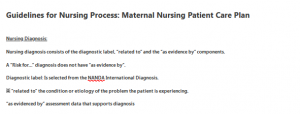Guidelines for Nursing Process: Maternal Nursing Patient Care Plan

Nursing Diagnosis:
Nursing diagnosis consists of the diagnostic label, “related to” and the “as evidence by” components.
A “Risk for…” diagnosis does not have “as evidence by”.
Diagnostic label: Is selected from the NANDA International Diagnosis.
“related to” the condition or etiology of the problem the patient is experiencing.
“as evidenced by” assessment data that supports diagnosis
| Assessment as evident by (AEB), or data collection relative to the nursing diagnosis | Outcome (objective, expected or desired outcomes or evaluation parameters
|
Interventions/
Implementations/ SHOULD HAVE RATIONALE FOR EACH INTERVENTION |
Evaluation
(Each OUTCOME needs an evaluation statement) |
|
Assessment supports the nursing diagnosis above. The assessment should reflect the “defining characteristics” that are expected to be present for that diagnosis to be appropriately utilized.
Types of data: subjective & objective Sources of data Nursing health history Physical examination Diagnostic data |
The OB care plan will focus on short term outcomes.
“What do you/your patient want to achieve today? …at next assessment?”
Should be acceptable by the patient and the nurse, realistic, specific and measurable
Stated realistic behavioral terms that can be observed, measured and relevant to the identified nursing diagnosis. |
Intervention –
The planned nursing actions that are likely to achieve the desired outcomes
Interventions should reflect on going assessment and activities that will assist in achieving the goal/outcomes.
Interventions should reflect independent nursing practice as well as collaborative practice.
Interventions should reflect the needs of this specific patient not a generic listing of possible interventions.
Interventions should include specifics like schedules, food choices, frequency, etc….
Rationales- reasoning behind your choosing the intervention; scientific explanation and/or underlying reason for which the intervention was chosen for your patient |
Focuses on change and compares the changes with the outcomes
Essentially this is a reassessment of the patient and the responses as to the interventions implemented.
Compare actual patient behaviors with expected behaviors.
Consider the effectiveness of the nursing intervention, time elements.
Give reasons why or why not each outcome has been met.
If the outcome is “unmet” what is your plan to meet outcome in the future or does the outcome need to be revised? |